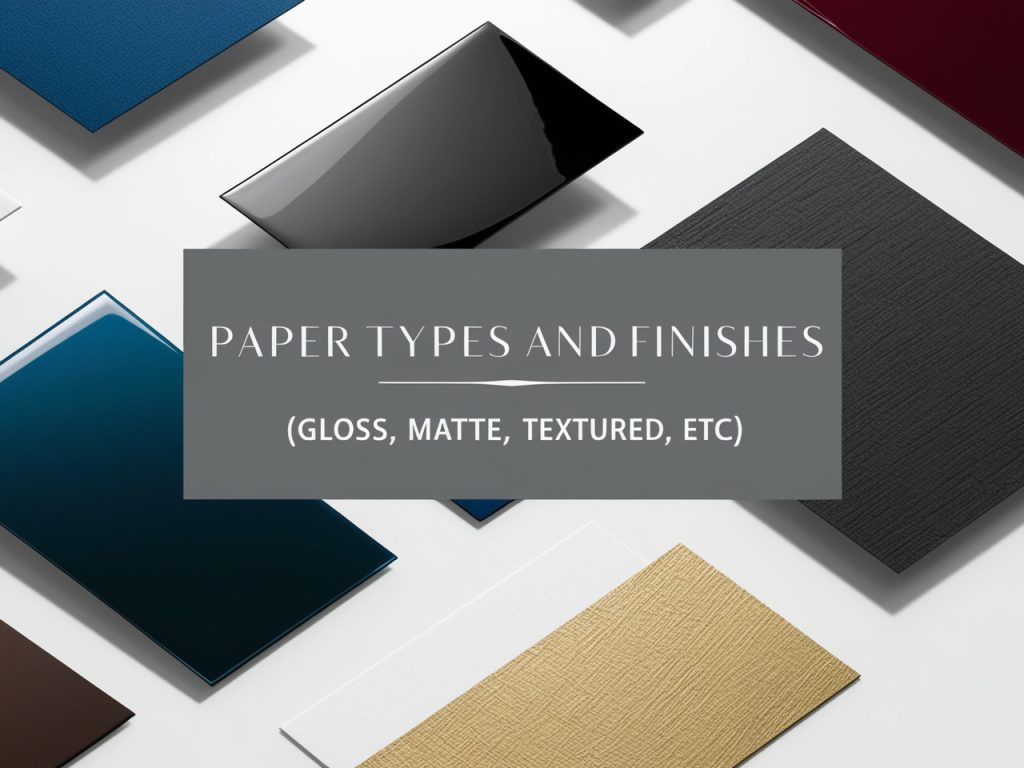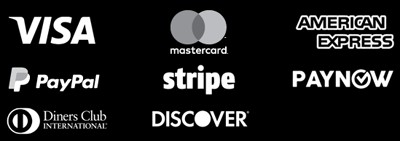
The type of paper and finish you choose for your printed materials plays a crucial role in their final look, feel, and overall impact. From the weight and thickness of the paper to its texture and surface finish, these elements can affect how your printed piece is perceived by your audience. In this guide, we’ll explore the most common paper types and finishes and help you decide which is best suited for your project.
1. Gloss Paper #
Gloss paper has a smooth, shiny finish that reflects light and enhances the vibrancy of colors. This paper type is ideal for materials that require bright, eye-catching visuals, such as photos, posters, and marketing brochures.
Best For: #
- Brochures
- Flyers
- Posters
- Magazines
- Business Cards
Benefits: #
- Vibrant Colors: Glossy paper makes colors pop, giving your images and designs a bold, bright appearance.
- Sharp Details: The smooth surface of gloss paper enhances the sharpness of text and images, making it great for projects that require high-definition graphics.
- Professional Look: Glossy finishes add a polished, professional touch to printed materials.
Drawbacks: #
- Reflective Surface: Gloss paper can be highly reflective, creating glare in certain lighting conditions.
- Shows Fingerprints: The shiny surface is more prone to showing fingerprints and smudges, especially on frequently handled items.
2. Matte Paper #
Matte paper offers a smooth, non-reflective finish that gives your printed materials a more understated and sophisticated look. It’s great for text-heavy projects where readability is key and for designs that require a more subtle finish.
Best For: #
- Business Cards
- Invitations
- Posters
- Booklets
- Text-Heavy Documents
Benefits: #
- Non-Reflective: Matte paper reduces glare, making it easy to read text even in bright light.
- Elegant Finish: The smooth, non-shiny finish gives a sleek, modern look, ideal for professional or luxury designs.
- Resistant to Fingerprints: Unlike gloss paper, matte paper is more resistant to fingerprints and smudges, keeping your prints looking clean.
Drawbacks: #
- Less Vibrant Colors: Colors may appear slightly muted on matte paper compared to gloss finishes, making it less ideal for projects that require bright, vibrant visuals.
3. Textured Paper #
Textured paper adds depth and a tactile element to your printed materials. Common textures include linen, felt, and laid finishes. These papers are often used for premium projects like invitations, business cards, or luxury stationery, giving your materials a unique, tactile feel that stands out.
Best For: #
- Wedding Invitations
- Certificates
- Business Cards
- Greeting Cards
- High-End Stationery
Benefits: #
- Premium Look and Feel: Textured paper adds a high-end, luxurious touch to your printed materials, making them feel more exclusive and memorable.
- Unique Texture: The physical texture engages the senses and enhances the user’s interaction with the material.
- Variety of Textures: Textured papers come in a wide range of finishes, such as linen (with a subtle, woven texture) or laid (with parallel lines), allowing for creative freedom.
Drawbacks: #
- Difficult to Print on: Some textured papers may not be ideal for high-resolution images or designs with small, intricate details, as the texture can interfere with the clarity of the print.
- Higher Cost: Textured papers tend to be more expensive than standard gloss or matte options.
4. Silk or Satin Paper #
Silk (or satin) paper offers a middle ground between gloss and matte finishes. It has a slight sheen that provides more vibrancy than matte but without the high reflectivity of gloss. This finish is often used for high-end marketing materials and luxury brochures.
Best For: #
- High-End Brochures
- Magazines
- Posters
- Catalogs
Benefits: #
- Subtle Shine: The soft sheen enhances the appearance of images and text without creating glare, making it ideal for projects where you want a touch of luxury.
- Smooth Surface: Silk paper has a smooth texture that is pleasing to the touch and adds a premium feel.
- Vibrant Colors: Offers better color vibrancy than matte while maintaining a more subtle finish than gloss.
Drawbacks: #
- Not as Shiny as Gloss: If you’re looking for bold, bright visuals, gloss paper may still be a better option, as silk paper is more subdued in terms of shine.
5. Uncoated Paper #
Uncoated paper has no additional coating or gloss, leaving it with a more natural, slightly rough texture. It is highly absorbent and is often used for items that need to be written on, such as letterheads, notepads, and forms.
Best For: #
- Stationery (Letterheads, Notepads)
- Business Forms
- Books
- Brochures
- Menus
Benefits: #
- Easy to Write On: Because it’s uncoated, this paper is ideal for materials that require handwritten notes or signatures.
- Natural Look: Uncoated paper gives a more organic, natural look to your printed materials.
- Soft, Tactile Feel: The rougher texture of uncoated paper can make it feel more substantial and less commercial.
Drawbacks: #
- Less Color Vibrancy: Colors may appear duller compared to coated papers, making it less ideal for visually intensive projects.
- Not Water-Resistant: Uncoated paper can easily absorb moisture and is less durable than coated papers.
6. Recycled Paper #
Recycled paper is an eco-friendly option made from post-consumer waste. It is available in a variety of finishes, such as gloss, matte, or uncoated, making it a versatile choice for environmentally conscious printing projects.
Best For: #
- Eco-Friendly Marketing Materials
- Stationery
- Packaging
- Brochures
- Business Cards
Benefits: #
- Environmentally Friendly: Recycled paper helps reduce your environmental footprint, making it a great choice for companies focused on sustainability.
- Variety of Finishes: Recycled paper is available in a range of finishes (gloss, matte, etc.), so you don’t have to compromise on quality or appearance.
- Promotes Green Initiatives: Using recycled paper can align your brand with sustainability efforts and appeal to eco-conscious customers.
Drawbacks: #
- Slightly Rougher Texture: Some recycled papers may have a rougher feel or less bright white appearance compared to non-recycled options.
- Higher Cost: Depending on the quality, recycled paper can sometimes be more expensive than traditional paper.
7. Coated Paper (Gloss and Matte) #
Coated paper refers to paper that has been treated with a coating to give it a smooth finish. This can be in the form of either gloss or matte. Coated paper is commonly used for marketing materials because it enhances the appearance of both text and images.
Best For: #
- Flyers
- Brochures
- Business Cards
- Posters
- Catalogs
Benefits: #
- Enhanced Visuals: Coated paper improves color reproduction, making your designs more vibrant and detailed.
- Smooth Finish: Whether you choose gloss or matte, coated paper has a smooth surface that elevates the look of your printed materials.
- Durability: Coated paper is more resistant to dirt, smudging, and moisture than uncoated paper, making it ideal for high-traffic materials like flyers and brochures.
Drawbacks: #
- More Expensive: Coated paper is generally more costly than uncoated paper, especially for premium finishes like gloss or silk.
- Hard to Write On: Coated paper is often slippery, making it difficult to write on with most pens.
Choosing the Right Paper and Finish for Your Project #
When deciding which paper type and finish to use for your project, consider the following factors:
- Purpose: What is the goal of your printed material? For marketing purposes, a glossy finish might help your design stand out, while a matte or silk finish may be better for business cards or high-end brochures.
- Design: Consider the colors and images in your design. If you need bold, vibrant visuals, gloss paper is ideal. For a more muted, elegant look, matte or textured paper may be a better choice.
- Durability: If your printed materials will be handled frequently or used outdoors, durability is important. Choose coated papers or finishes that can withstand wear and tear, such as gloss or silk.
- Sustainability: If eco-friendliness is a priority, opt for recycled paper or FSC-certified materials to reduce your environmental impact.
Conclusion #
Choosing the right paper type and finish is crucial to the success of your printed materials. Whether you’re designing business cards, brochures, posters, or invitations, selecting the appropriate combination of paper and finish can enhance the overall impact and professionalism of your project. By understanding the characteristics of gloss, matte, textured, and other paper finishes, you can make an informed decision that aligns with your goals and audience.
You can find free business card templates on Freepik.
Learn more about the different printing methods in this comprehensive guide.





